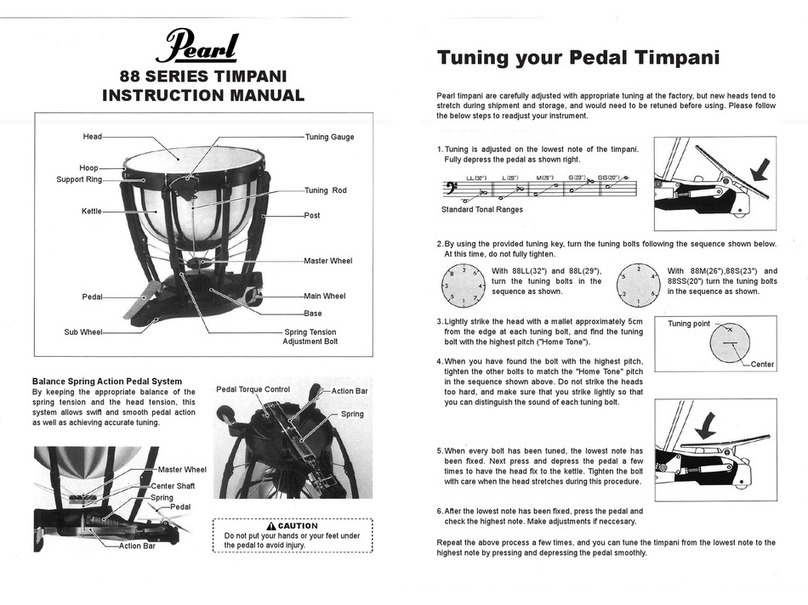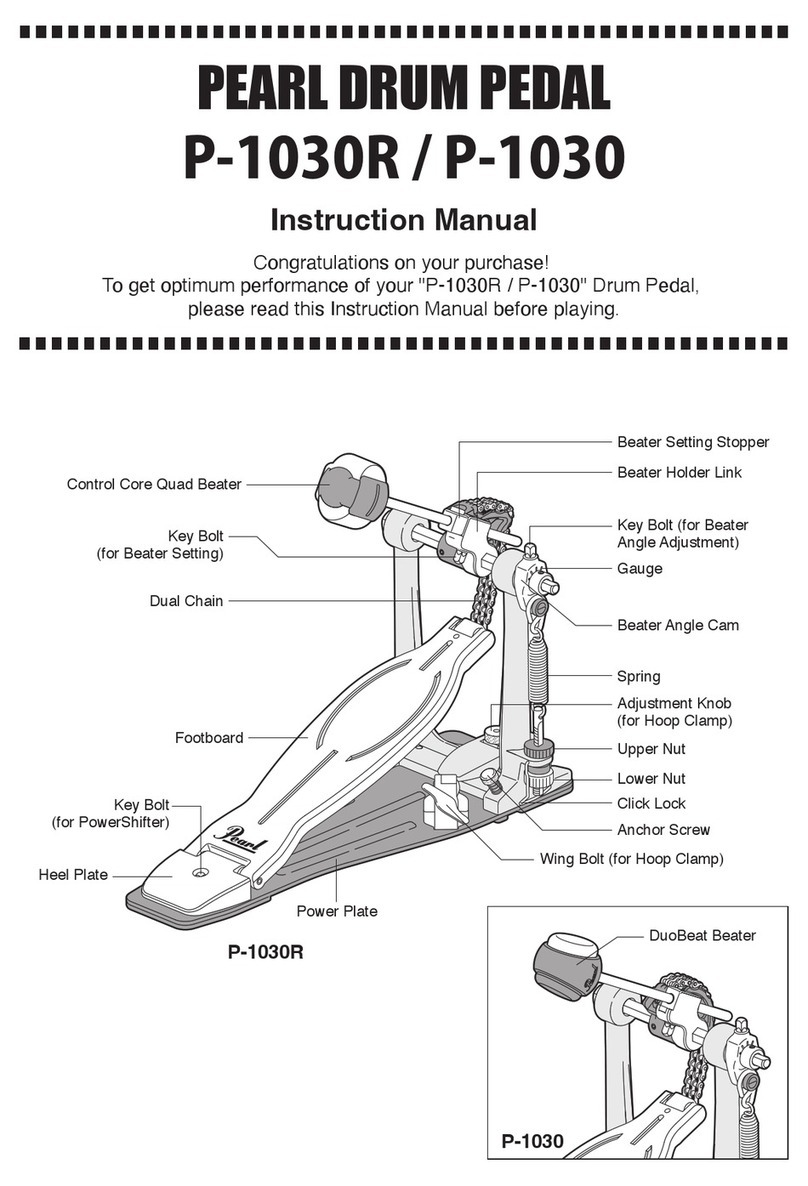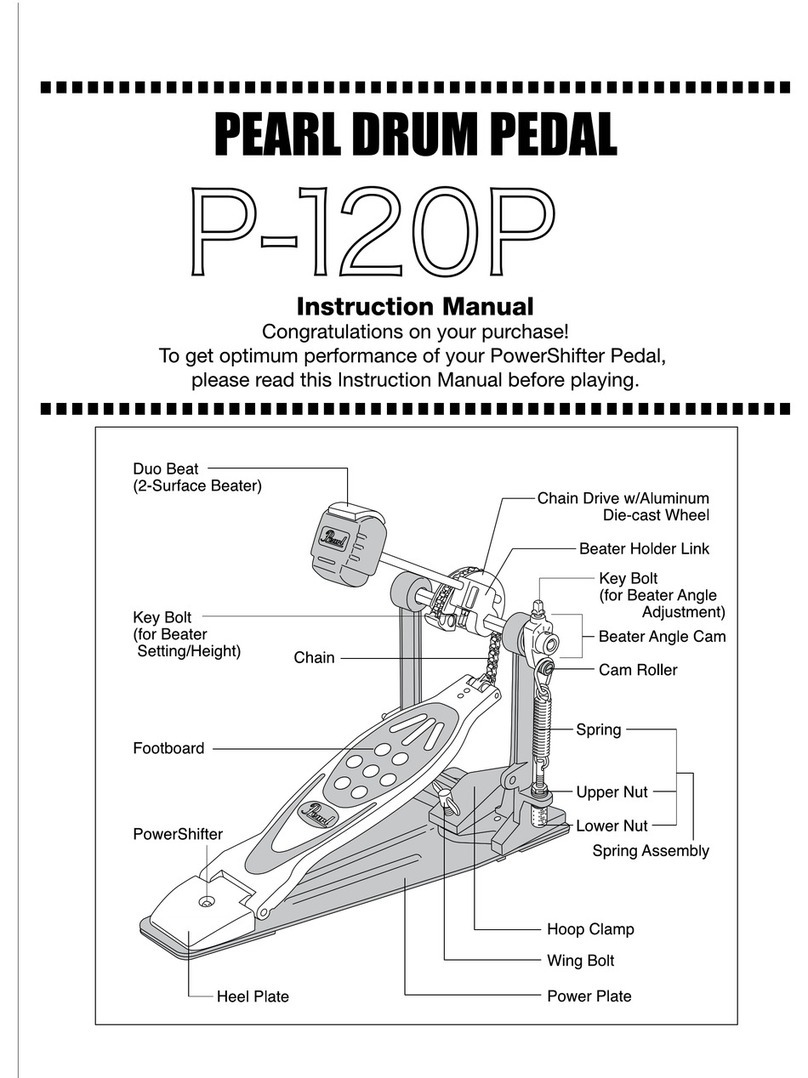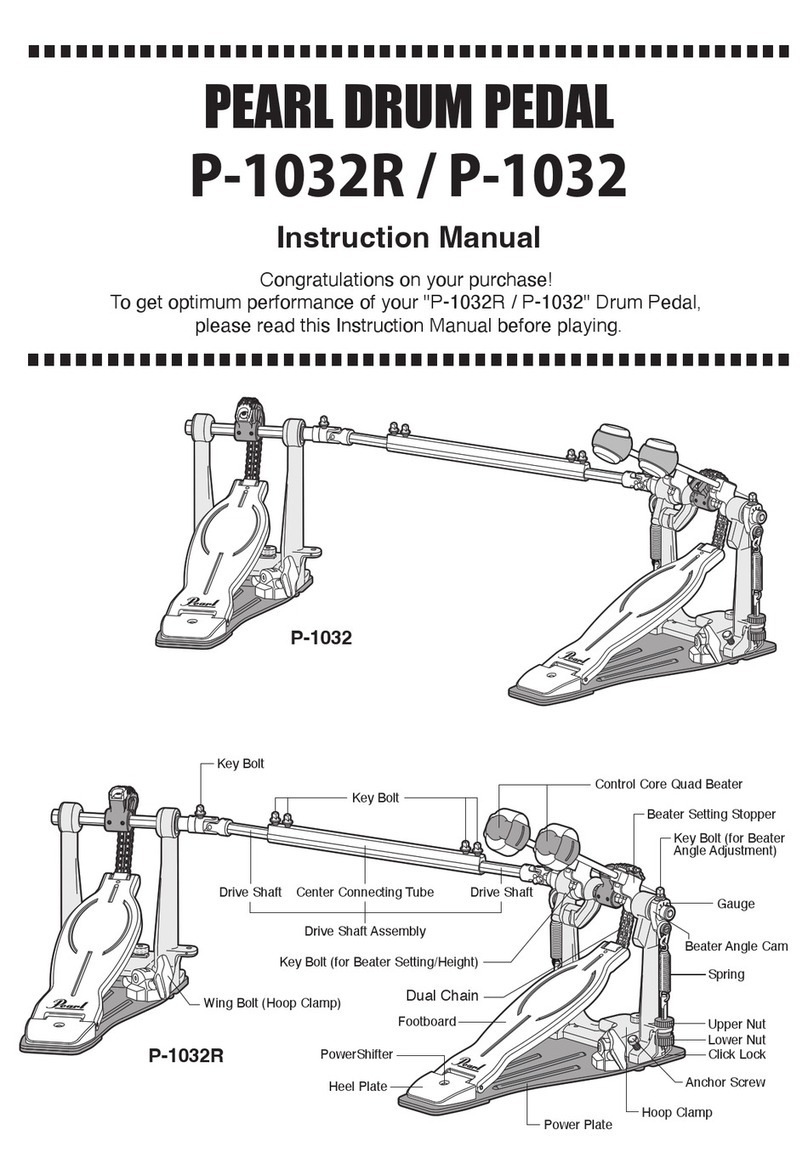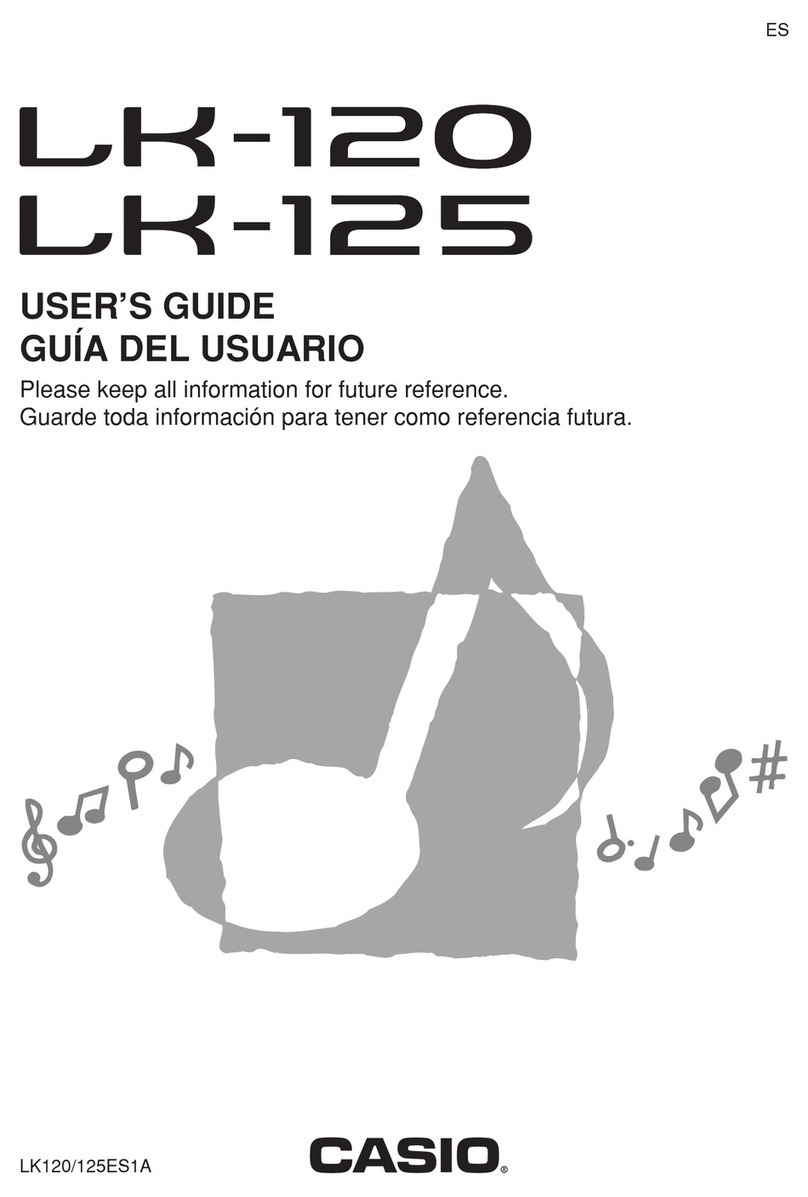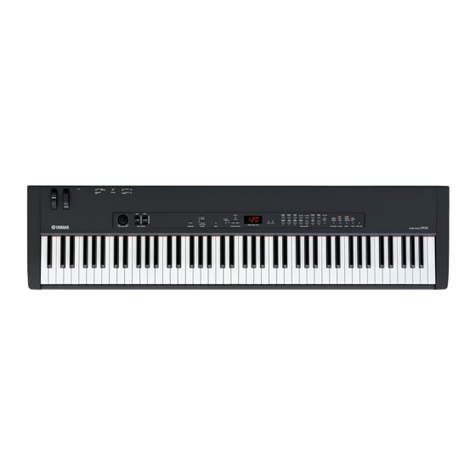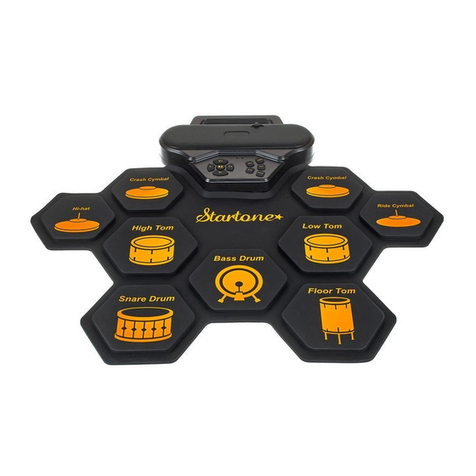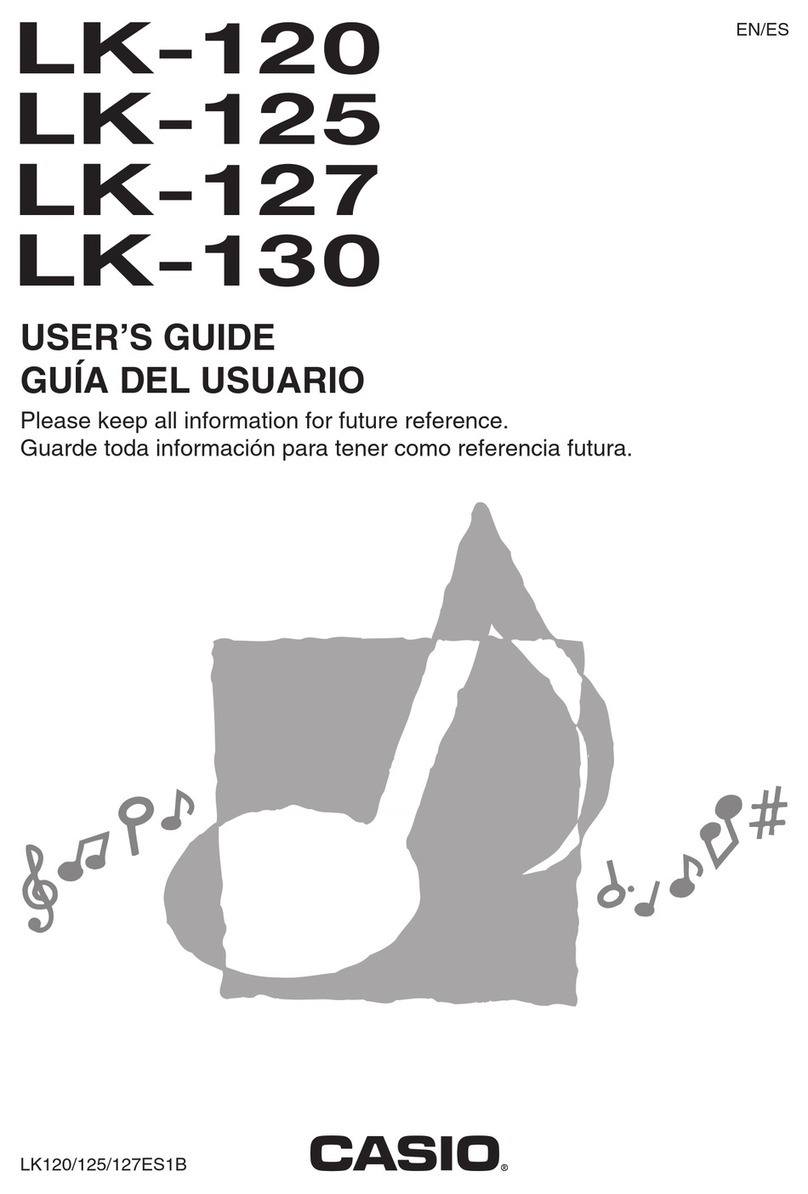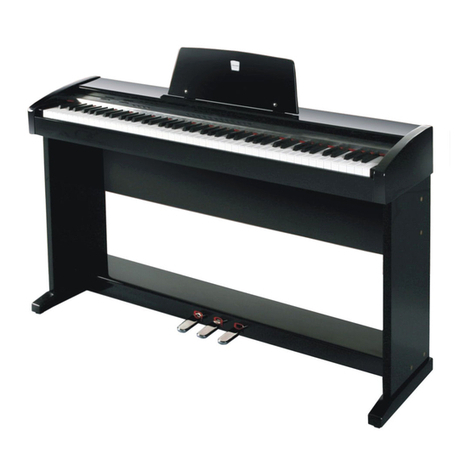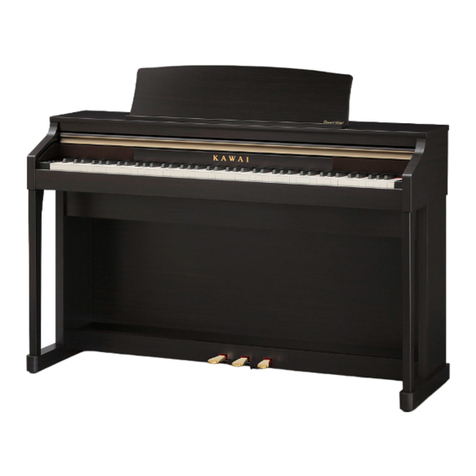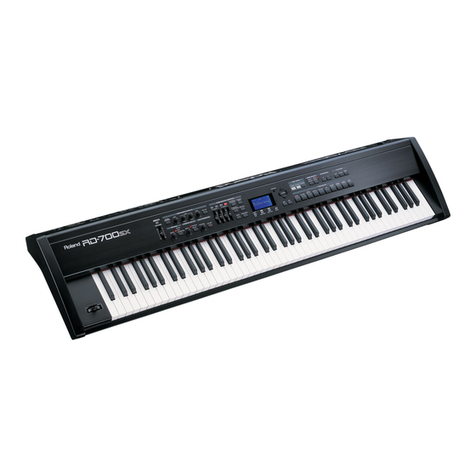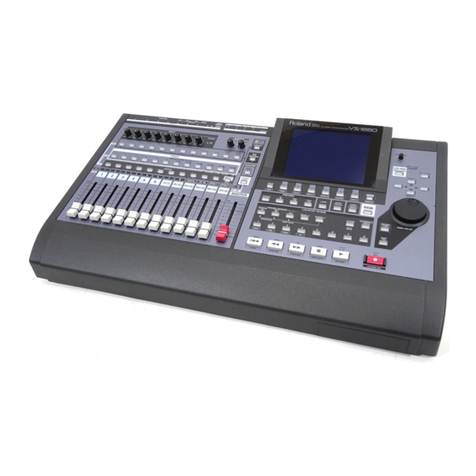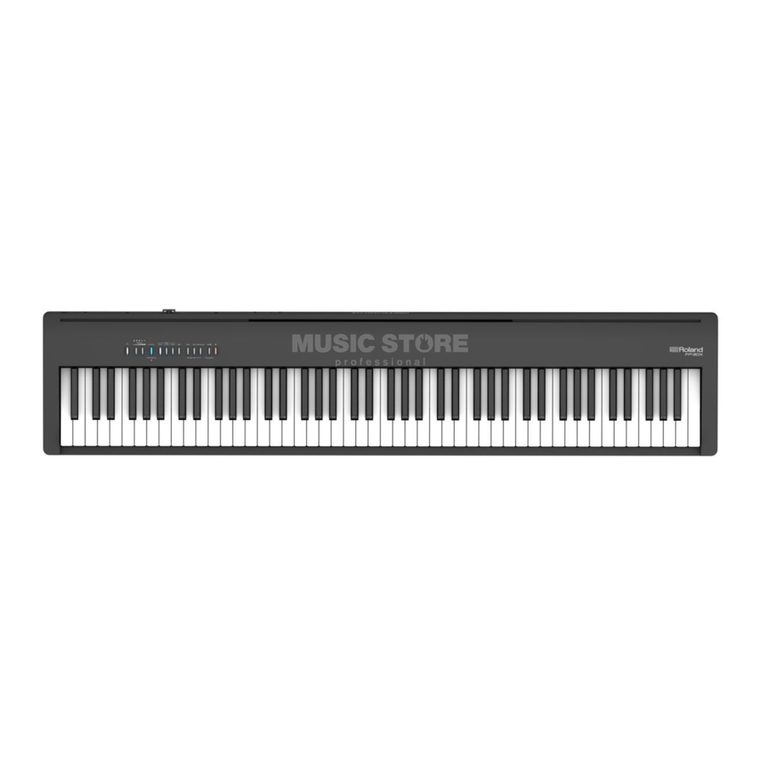Pearl MIDTOWN User manual

Congratulations on your purchase!
For optimum performance, please read this Instruction Manual before playing.
Instruction Manual
Set-Up Example
· Bass Drum Shell x1
· Bass Drum Heads x1pr
· Bass Drum Hoops x1pr
· Bass Drum Tension Rods, Claws x12
· Bass Drum-Mounted Cymbal Holder x1
· Tom Tom x1
· Tom Holder x1
· Floor Tom Shell x1
· Floor Tom Heads x1pr
· Floor Tom Hoops x1pr
· Floor Tom Tension Rods x12
· Floor Tom Legs x3
· Hi-Hat Stand x1
· Drum Pedal x1
· Pedal Clamp Plate x1
· Snare Drum x1
· Snare Stand x1
· Cymbal Boom Stand x1
· Tuning Key x1
Contents
Snare Drum
Bass Drum
Cymbal Boom
Stand
Floor Tom Legs
Tom Holder
Tom Tom
Hi-Hat Stand
Bass Drum-Mouted
Cymbal Holder
Floor Tom
Snare Stand
Drum Pedal
Pedal Clamp Plate

Warning
Warning Caution
Caution
Thank you for choosing Pearl! Before use, please follow these instructions carefully for safe and proper assembly and operation of your
drums, stands, pedals, and accessories. Please keep these instructions in a safe place for future reference.
Hazard Signs
The three Hazard Signs, as shown below, appear periodically throughout the product instructions to alert the user or others to possible
danger or injury. For safe assembly and use of this, or any Pearl product, never ignore a Hazard Sign and ensure the threat level and
corresponding instructions are entirely understood.
SAFETY PRECAUTIONS FOR ASSEMBLY AND USE
Pearl Musical Instrument Company and Affiliates cannot be held responsible for personal injuries or property damage caused by
the misuse, improper handling, failure to follow product warnings and instructions, or product use outside of its intended purpose.
Warning
SAFETY PRECAUTIONS
Tighten and Secure All Moving Parts
Ensure all wing bolts, wing nuts, geared tilters,
bass drum spurs, and clamps are tight and secure
after assembly or adjust-
ment. Failure to do so will
cause the hardware to fall
over or drop/slip during use
and may result in personal
injury or property damage.
Precautions When Handling Equipment
Risk of fatal or severe personal injury
and/or property damage.
Caution
Risk of injury to person(s) handling the
equipment and/or to personal proper-
ty.
The performance or function of the
equipment may be adversely affected
and may result in permanent damage.
●
Avoid Damage To Floor Surfaces
The bass drum spurs and hi-hat stand have sharp
tips/anchors to keep them stationary during use.
The pointed ends may gouge or damage bare
floors, and the rubber tips may cause discoloration
to floor surfaces if left in place over time. To
prevent floor surface damage, always place the
drum-set on carpet or a specially designed drum
mat.
Stabilizing Stands
Open the tripod base to a wide stance to ensure
stability and prevent the stand from tipping over
during use. When
mounting a tom or
boom cymbal,
always position
them directly over a
leg of the tripod for
optimum stability.
Earthquake Precautions
A strong vibration such as an earthquake can cause
your drums and hardware to shift and tip over. Stay
well clear of falling objects to avoid injury.
Note
Objects with Rough or Pointed Shapes
Some parts, such as knurled posts, hi-hat rods, and
tension rods have roughened or pointed shapes that
can scratch surfaces or get caught, for example, on
clothes or carrying bags. Please handle these parts
with extra caution to avoid mishaps.
Bass Drum Head Sound Control Hole
Some bass drum heads are equipped with a hole
for sound control and microphone placement. The
edges of the hole are sharp; use caution to avoid
contact to prevent injury when handling, placing
microphones, or muffling the drum.
Anti-Slip Spikes
The spikes (used on bass drum spurs, hi-hat legs,
snare stand legs and some other products) are
sharp and can cause serious personal or property
injury. To prevent mishaps, use extreme care when
handling these products especially when the spike
tips are exposed.
Folding Stand Legs
When folding the legs on stands, be careful not to
pinch your fingers between any moving parts.
Handling Tubing
Do not put your fingers into the tubes when handling
tubular hardware. Doing so may result in injury.
Adjusting Throne Settings
Sitting on a drum seat while adjusting height
settings can cause the seat to drop suddenly and
pinch your fingers and/or cause other bodily
injuries. Sitting on the drum seat while making
adjustments may require twisting and reaching that
can also cause bodily injuries. To prevent injury,
perform these adjustments before sitting, test, and
repeat as necessary until the best comfort/support
is achieved.
Be Careful Using Sticks and Wire Brushes
Sticks and wire brushes are intended for playing
the drums and should
never be used to hit or to
be thrown at people.
Doing so can be extreme-
ly dangerous.
Broken Sticks
Fragments and splinters
from broken drumsticks
can fly into the air and
cause injury to the player
and/or to those nearby.
The Drum Throne is Not a Step Stool
Standing on a drum throne and
using it as a step stool may cause it
to break and fall over. Never use
the drum throne for anything other
than its designated purpose, that is,
to sit on while playing.
Be Careful Around Drum Sets and Stands
Hardware, drums, cymbals, and percussion devic-
es protruding from drum sets may cause people
walking by or children playing nearby to trip and
stumble into the drum set resulting in severe bodily
injury and/or damage to equipment. Exercise
extreme caution when moving about your set and
closely supervise children who may be playing in
the vicinity of your set.
Adjustments
Use two hands when adjusting
the height and angle of drums,
cymbals, practice pads, etc. Use
one hand to support the object
being adjusted to keep it from
falling while making adjustments
with your other hand.
Precautions with Oil and Grease
Hardware such as tension rods, wing nuts, and
wing bolts are lubricated with grease or oil from the
factory. Use caution when handling to avoid skin or
clothing contact. If exposed, wash any surface with
soap and water immediately.
Precautions with Rust or Sharp Edges
Metal parts may become rusty and scratched
through use. Rusty surfaces can be sharp, and
care must be taken to prevent injury to your hands
and feet. Metal surfaces, such as footboards, may
develop sharp edges from contact with other
stands, especially during transport. Examine metal
parts periodically and repair them immediately to
prevent injury to your hands and feet.
Metal Care
To prevent rust, all metal parts on drums and
hardware should be wiped with a clean dry cloth
immediately after exposure to moisture. Periodically
polish metal parts to protect against rusting and to
maintain the beauty of fittings and hardware. Should
rust occur, remove the rust with commercial removal
products and use caution to prevent cuts to your
hands from sharp edges that may be present.
Precautions Regarding High Temperatures
and Humidity
Leaving your drums in places with high heat, such as
in a car or in direct sunlight, can cause the covering
to come loose. To maintain the pristine condition of
your drums and hardware, store them in places with
controlled and comfortable temperature and humidity.
Precautions Regarding High Temperatures
and Ultraviolet Light (UV from the Sun)
To maintain the pristine condition of your drum finish
covering, avoid long periods of exposure to Ultraviolet
Light (direct Sun-Light) or very high temperatures.
Note

Bass Drum Spur
Bass Drum Hoop
Front Head (w/Logo)
Shell
4. Insert the post of the Pedal Clamp Plate into the Pedal
Clamp Plate Bracket as shown and tighten the Wing
Bolt to secure. Loosen the Wing Nut on the Bass Drum
Spur and rotate it to the position shown in Fig.6.
Tighten the Wing Nut to secure. Loosen the Wing Bolt
and extend the Spurs making sure that both sides are
equal in length, and tighten the Wing Bolt to secure.
The Bass Drum Spurs have Spike Tips (for added slip
resistance) that can be exposed by turning the Lock
Nut and Rubber Tip clockwise (Fig.5).
1. Place the Shell on a clean, solid surface with the front
side (the side with the Bass Drum Spurs attached)
facing upwards. Put the Front Head with Pearl Logo on
the Shell then attach the Bass Drum Hoop with flat side
down on the Rim of the Head (Fig.1).
3.
Turn the shell over to the batter side and place the other
Head and Bass Drum Hoop on the Shell. Position the Bass
Drum Hoop so that the cutaway is aligned with the Clamp
Plate Bracket (Fig.3). Attach the Tension Rods/Hooks in
the same way as the front side (Fig.4).
Bass Drum Assembly
The Bass Drum is packed with the Shell, Bass Drum
Hoops, Heads and Parts unassembled. Please follow the
instructions below to assemble the Bass Drum.
Fig.2
Fig.3
2. Pass a Tension Rod through a Hook, and hook it on the
Bass Drum Hoop above a Lug. Finger tighten the
Tension Rod into the Lug and do the same with the rest
of the Tension Rods/Hooks on this side of the drum
(Fig.2). Using a Tuning Key, tighten the Tension Rod
until secure.
CAUTION
The Spike Tips are sharp. Be careful not to hurt yourself or
others when using them. Use the Spike Tips only on thick
carpeted surfaces to prevent damage to the flooring underneath.
Note
To identify the top of the drum, check that both the Tom
Holder and “L” Rod Cymbal Holder Bracket are present.
Check to ensure that the front Bass Drum Hoop does
NOT include the cutaway for the pedal.
Tension Rod
Hook
Lug
Bass Drum Hoop
Hook
Head
Tension Rod
Bass Drum Hoop
Cutaway
Pedal Clamp Plate Bracket
Bass Drum Hoop
Cross-section
drawing
Fig.1
(Front Side)
Fig.4
(Batter Side)
Fig.5
Pedal
Clamp
Plate
Pedal Clamp
Plate Bracket
Wing Bolt
Wing Bolt
Wing Nut
Bass Drum Spur

Tom Tom Setting
Insert the long ends of the Tom Holders into the Tom
Holder Bracket on the Bass Drum as shown (Fig.7) and
tighten the Wing Nut on the Tom Holder Bracket. Next,
loosen the Wing Nut on the Tom Holder. Adjust the angle
of the Tom Holder so you can attach the Tom Tom easily
then retighten the Wing Nut (Fig.8). Attach the Tom Tom
to the other end of the Tom Holder and tighten the Wing
Nut on the mounts on the Tom Tom.
Drum Pedal Setting
Position the Bass Drum upright as shown and attach your
Bass Drum Pedal to the Pedal Clamp Plate. Adjust the
height of the Pedal Clamp Plate and the length of the
Spurs if necessary. When making the adjustment, hold the
Bass Drum with one hand to prevent the drum from falling
over. When the height is set, make sure to tighten the
Wing Bolt on the Clamp Plate Bracket and the Spurs, and
the Stop Lock on the Pedal Clamp Plate (Fig.6).
Note
The Tom Holders are equipped with StopLocks that keep the
drums from slipping or rotating and to memorize position
settings for quick and repeatable set-ups. When the position
of the Tom Toms are set, place each StopLock into the slots
in the Tom Holder Bracket and the mounts on the Tom Toms
to retain these settings (Fig.9).
Fig.6
Fig.9
Fig.7
Fig.8
Pedal Clamp Plate
Tom Holder Bracket
StopLock
Key Bolt
Wing Nut

Floor Tom Assembly
The Floor Tom is packed with the Shell, Steel Hoops,
Heads and Floor Tom Legs unassembled. Please follow
the assembly instructions below to assemble the Floor
Tom.
1. Place the Shell on a clean, solid surface with the batter
side facing upwards as shown in Fig.12. Put the Head
on the Shell followed by the Steel Hoop.
2. Line up the ears of the Steel Hoop over the Lugs and
insert the Tension Rods through the ears. Finger
tighten them into all the Lugs on this side of the drum.
Using a Tuning Key, tighten the Tension Rods until
secure (Fig. 12).
3. Turn the drum over and attach the other Head and
Steel Hoop with the remaining Tension Rods.
4. Attach the Floor Tom Legs to the Floor Tom Leg
Brackets and set the height and angle to your
preference. Tighten the Wing Bolt to secure position
(Fig.12,13).
Fig.12
Fig.13
Tension Rod
Lug
Steel Hoop
Head
Floor Tom Leg
Wing Bolt
Floor Tom Leg
Bracket
Cymbal Holder Assembly
1. Insert the L-Rod into the Bracket and tighten the Wing
Nut (A), as shown in (Fig.10).
2. Set the Stop Lock inside the corresponding slot of the
Bracket, then tighten the Key Bolt to secure.
Wing Nut (A)
L-Rod
Upper Tube Assembly
Wing Nut (C)
Wing Nut (B)
Cymbal Tilter
Fig.10
Fig.11
Wing Nut (A)
L-Rod
Key Bolt
Bracket
3. Install the Upper Tube Assembly with Tilter onto the
L-Rod and set it to the desired height/angle and tighten
Wing Nut (B).
4. Loosen Wing Nut (C) of the Upper Tube Assembly
w/Cymbal Tilter to set the cymbal tilt.
5. Install the Cymbal onto the Cymbal Tilter and position it
to your playing preference and secure all Wing Nut and
Stop Lock (Fig.11)

Upper
Pull Rod
Beater
Beater Holder
Beater Angle Cam
Spring
Wing Bolt
Hoop Clamp
Spring Adjustment Nut
Footboard
Key Bolt
Hi-Hat Stand Assembly
Open the legs of the hi-hat to form a stable tripod. Insert
the ends of the radius rod into the holes near the bottom
of the hi-hat base (Fig.14). Thread the upper pull rod into
the connector as shown (Fig.15).
Place the upper tube over the upper pull rod and into the
tripod base and set the height to your preference. Rest
the lower hi-hat cymbal on the hi-hat cup. Attach the top
hi-hat cymbal to the clutch in the order shown then slide
the clutch with the top cymbal attached onto the upper
pull rod. Adjust the distance between the top and lower
hi-hat cymbals to your preference by stepping on the
pedal and tightening the wing-bolt on the clutch when the
desired distance is achieved.
Fig.14
Upper Pull Rod
Hi-Hat Clutch
Wing-Bolt
Hi-Hat Cup
Upper Tube
Wing-Bolt
Radius Rod
Drum Pedal Assembly
Insert the ends of the radius rod into the holes near the
bottom of the pedal base. With the pedal flat on the floor,
insert the beater into the beater holder link and secure it
with the provided tuning key (Fig.16).
Clip the pedal to the Pedal Clamp Plate and tighten the
wing-bolt to secure the hoop clamp. Check the key-bolt
at the top of the beater angle cam to ensure it is tight.
Test the pedal and adjust the spring tension to your
preference by adjusting the upper and lower nuts below
the spring. To adjust the beater angle, loosen the key-bolt
of the beater angle cam and rotate the beater to your
preference and tighten. Please note this will also affect
the foot-board height (Fig.17).
Fig.16 Fig.17
Fig.15Attaching the Upper Pull Rod
Hi-Hat Cup
Hi-Hat Clutch
Bottom Lock Nut
Wing-Bolt
Felt Washer
Top Hi-Hat Cymbal
Lower Hi-Hat Cymbal
Upper Tube
Die-Cast Joint

6 / Tension Rod
8 / Tension Rod
30 ~ 40mm
Tuning Point
Basic Tuning
Here is the basic tuning method using the snare drum as
an example. Gradually tighten the tension bolts diagonally
as shown to raise the overall
pitch of the head. Tap the head
at each tension rod near the rim
(tuning point) as shown below
and listen to the pitches.
Adjust the tuning as needed to
achieve uniform pitch all around
the head. Most drummers tune
the bottom head of the snare
drum slightly highter than the
top.
Basically, the tom toms and
bass drum are tuned the same
way as the snare drum.
However, there are three ways
to tune the top and bottom
heads: tune both heads to the
same pitch, tune the bottom
head tighter than the top, or
tune the bottom head looser
than the top. Experiment to find
the tuning method that works
best for you.
If you find that the drums have
too much “ring,” you can
control it with after-market drum
heads or muffling devices. A
simple and effective way to
muffle your bass drum is to put
a blanket or pillow inside.
1
2
3
4
5
6
1
2
34
58
76
Tap for Note
Snare Stand Assembly
Open the legs of the stand to form a stable tripod and
insert the top section into the base. Open the basket and
adjust the tilter, so the basket assembly is flat. Adjust the
center knob as needed to accommodate the snare drum.
Place the snare drum into the basket and tighten the
center knob to secure the drum (Do not overtighten)
(Fig.18).
Strainer
Center Knob
Basket
Wing Nut
Tilter
Stand Base
Basket Assembly
Wing Bolt
Wing Bolt
Fig.18

Please refer to the Set-Up Example on the cover
page of this manual to see the completed kit.
Make sure that all Wing Bolts, Wing Nuts, Bolts and
Screws on the Stands and the Drums are tight
before playing on your drum set.
CAUTION
https://pearldrum.com
Products and specifications are subject to change without notice.
Printed in China
-2307-
Other Pearl Musical Instrument manuals
